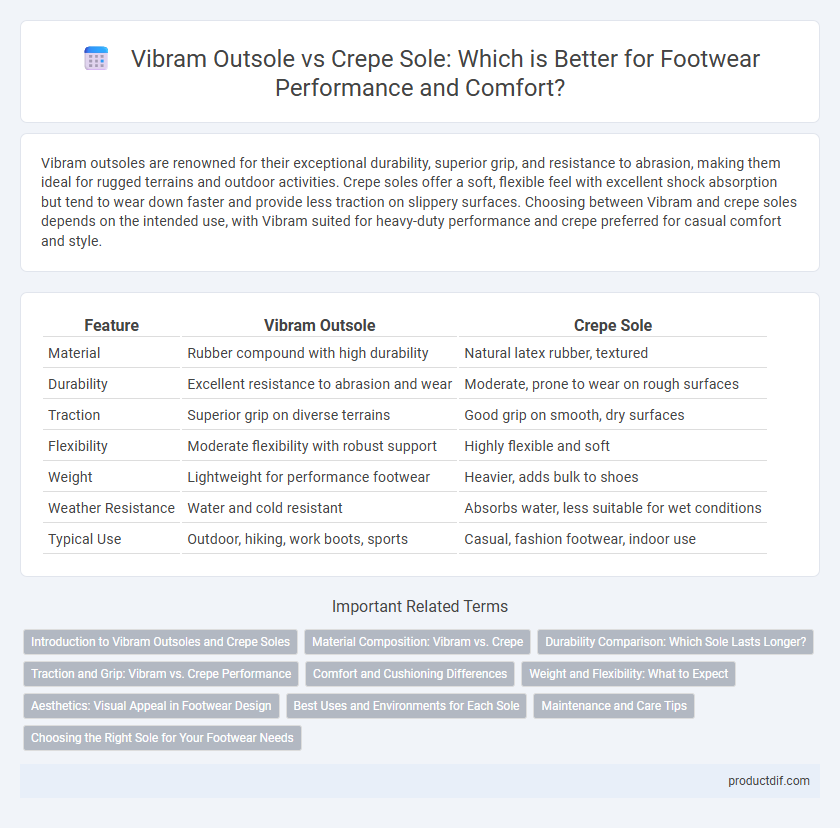Vibram outsoles are renowned for their exceptional durability, superior grip, and resistance to abrasion, making them ideal for rugged terrains and outdoor activities. Crepe soles offer a soft, flexible feel with excellent shock absorption but tend to wear down faster and provide less traction on slippery surfaces. Choosing between Vibram and crepe soles depends on the intended use, with Vibram suited for heavy-duty performance and crepe preferred for casual comfort and style.
Table of Comparison
| Feature | Vibram Outsole | Crepe Sole |
|---|---|---|
| Material | Rubber compound with high durability | Natural latex rubber, textured |
| Durability | Excellent resistance to abrasion and wear | Moderate, prone to wear on rough surfaces |
| Traction | Superior grip on diverse terrains | Good grip on smooth, dry surfaces |
| Flexibility | Moderate flexibility with robust support | Highly flexible and soft |
| Weight | Lightweight for performance footwear | Heavier, adds bulk to shoes |
| Weather Resistance | Water and cold resistant | Absorbs water, less suitable for wet conditions |
| Typical Use | Outdoor, hiking, work boots, sports | Casual, fashion footwear, indoor use |
Introduction to Vibram Outsoles and Crepe Soles
Vibram outsoles are engineered using durable rubber compounds offering superior traction and abrasion resistance, ideal for rugged outdoor and athletic footwear. Crepe soles, made from natural coagulated latex, provide a soft, cushioned feel with distinctive texture but are less resistant to wear and water compared to Vibram soles. Each sole type caters to different footwear needs, balancing durability and comfort based on usage.
Material Composition: Vibram vs. Crepe
Vibram outsoles are composed of high-performance synthetic rubber compounds engineered for superior durability, abrasion resistance, and traction on diverse surfaces. Crepe soles are made from natural latex rubber, providing a soft, flexible, and lightweight feel but with less wear resistance compared to Vibram's advanced formulations. The specialized materials in Vibram outsoles enhance their longevity and grip, making them ideal for rugged outdoor use, while crepe soles offer comfort and shock absorption primarily suited for casual footwear.
Durability Comparison: Which Sole Lasts Longer?
Vibram outsoles are renowned for their exceptional durability, offering superior resistance to abrasion and wear due to their high-performance rubber compounds designed for rugged conditions. Crepe soles, made from natural rubber, provide comfort and flexibility but tend to wear down more quickly, especially on rough surfaces. When longevity is prioritized, Vibram outsoles generally outperform crepe soles, making them a preferred choice for heavy-duty and outdoor footwear.
Traction and Grip: Vibram vs. Crepe Performance
Vibram outsoles offer superior traction and grip due to their advanced rubber compounds and multidirectional lug patterns, making them ideal for rugged terrain and wet conditions. Crepe soles, made from natural rubber, provide a softer grip suitable for casual wear but lack the durability and traction needed for demanding surfaces. Performance-wise, Vibram outsoles outperform Crepe soles in stability and slip resistance, especially on uneven or slippery ground.
Comfort and Cushioning Differences
Vibram outsoles provide superior cushioning and shock absorption through advanced rubber compounds and lug designs, enhancing comfort during prolonged wear and varied terrain. Crepe soles, made from natural latex rubber, offer a softer, more flexible feel but tend to compress faster, reducing long-term cushioning and support. The choice between Vibram and crepe soles significantly impacts foot comfort, with Vibram excelling in durability and cushioning retention while crepe soles emphasize initial softness and flexibility.
Weight and Flexibility: What to Expect
Vibram outsoles are renowned for their lightweight construction, making them ideal for activities requiring agility and endurance, while offering exceptional flexibility due to their advanced rubber compounds. Crepe soles, made from natural latex, tend to be heavier and provide a softer, more cushioned feel but lack the same level of flexibility and responsiveness found in Vibram soles. When choosing between the two, expect Vibram to deliver superior performance in weight and flexibility, whereas Crepe soles prioritize comfort and traditional styling.
Aesthetics: Visual Appeal in Footwear Design
Vibram outsoles offer a sleek, modern appearance with textured tread patterns that enhance rugged or sporty footwear designs. Crepe soles provide a distinctive, natural look characterized by a slightly translucent, creamy rubber texture ideal for vintage or casual styles. The choice between Vibram and crepe soles significantly influences the shoe's overall aesthetic, balancing contemporary durability with classic charm.
Best Uses and Environments for Each Sole
Vibram outsoles excel in rugged outdoor environments, providing superior traction, durability, and slip resistance on wet or rocky surfaces, making them ideal for hiking, mountaineering, and trail running. Crepe soles offer excellent comfort and flexibility, best suited for casual wear or indoor settings where cushioning and quiet steps are prioritized over extreme durability. Choosing Vibram outsoles enhances performance in demanding terrains, while crepe soles offer relaxed wearability in everyday urban or indoor environments.
Maintenance and Care Tips
Vibram outsoles require minimal maintenance, typically needing only regular cleaning with a stiff brush to remove dirt and debris, while avoiding harsh chemicals that can degrade the rubber compound. Crepe soles demand more careful upkeep, as their natural rubber material is porous and can absorb moisture, leading to faster wear, so they benefit from occasional application of leather conditioner on the upper and keeping soles dry. Proper storage in a cool, dry environment extends the lifespan of both Vibram and crepe soles by preventing damage from heat or humidity.
Choosing the Right Sole for Your Footwear Needs
Vibram outsoles offer superior durability, traction, and resistance to abrasions, making them ideal for hiking boots, work shoes, and outdoor footwear requiring long-lasting performance on varied terrains. Crepe soles provide excellent cushioning and flexibility with a distinctive textured appearance, often preferred for casual and vintage-style shoes that prioritize comfort and classic aesthetics. Selecting the right sole depends on the footwear's intended use, where Vibram excels in rugged, performance-driven environments while crepe soles suit everyday wear and softer surfaces.
Vibram outsole vs Crepe sole Infographic

 productdif.com
productdif.com